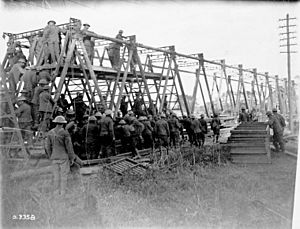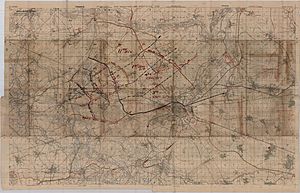Battle of the Canal du Nord facts for kids
Quick facts for kids Battle of Canal du Nord |
|||||||
|---|---|---|---|---|---|---|---|
| Part of the Hundred Days Offensive of the First World War | |||||||
 Canadian engineers building a bridge across the Canal du Nord, September 1918 |
|||||||
|
|||||||
| Belligerents | |||||||
|
|||||||
| Commanders and leaders | |||||||
| Strength | |||||||
| 13 divisions | |||||||
| Casualties and losses | |||||||
| 30,000 | 36,500 POW 380 guns |
||||||
The Battle of Canal du Nord was a key part of the Hundred Days Offensive during the First World War. This battle saw the Allied forces fight against German troops. It happened in France, near the Canal du Nord and the city of Cambrai. The fighting lasted from September 27 to October 1, 1918.
This attack was one of several big Allied attacks happening at the same time. The goal was to stop Germany from moving its soldiers to reinforce any single battle. The Battle of Canal du Nord started just after the Meuse-Argonne Offensive. It was also a day before a big attack in Belgian Flanders and two days before the Battle of St. Quentin Canal.
British armies, the First Army and Third Army, led the attack. They aimed to continue their advance after earlier battles. The First Army's main job was to cross the Canal du Nord. It also had to protect the side of the British Third Army as both armies moved towards Cambrai. The Third Army also needed to capture the Escaut (Scheldt) Canal. This would help the Fourth Army during the Battle of St. Quentin Canal.
Contents
Why was the Canal du Nord Important?
Building the Canal
Work on the Canal du Nord began in 1913. It was meant to connect the Oise River to another canal. But when the First World War started, construction stopped. Different parts of the canal were at different stages of completion.
A Tough Obstacle
During their retreat, the Germans made the area around the canal very hard to cross. They blew up bridges and flooded the already wet ground. This made it almost impossible to get across.
The only part that was mostly dry was a small section. It was about 3.6 kilometers (2.2 miles) long. Even though it was unfinished, this dry part of the canal was still a huge barrier. The canal was about 36 meters (40 yards) wide. Its western bank was 3 to 4.5 meters (10 to 15 feet) high. The eastern bank was about 1.5 meters (5 feet) high. The British First Army had to stop its attack until they could find a way to cross.
German Retreat and New Defenses
On September 2, 1918, the British attacked the Drocourt-Quéant Line. This forced the Germans to pull back. German commanders ordered their armies to retreat behind the Sensée River and the Canal du Nord. They also moved back to the strong Hindenburg Line.
British air patrols saw no German soldiers between the Dury Ridge and the Canal du Nord. The British Third Army moved into towns without a fight. They saw that the Germans were retreating across a wide area. As the British got closer to the new German front line, they found the east bank of the Canal du Nord strongly defended. Most canal crossings were destroyed.
Planning the Attack
A Big Allied Plan
On September 3, 1918, the main Allied commander, Ferdinand Foch, planned the next steps. He wanted to attack the Germans in four different places. These attacks would happen on four separate days. This was to stop Germany from gathering all its soldiers in one spot.
The plan included:
- An attack in Flanders, Belgium, led by King Albert I of Belgium.
- The British First and Third Armies attacking the Canal du Nord and Cambrai. Cambrai was a vital German supply center.
- The British Fourth Army and French First Army attacking the Saint-Quentin Canal.
- The American and French armies launching the Meuse-Argonne Offensive further south.
German Defenses at Canal du Nord
The Canal du Nord was Germany's last major defense line against the British First Army. The Germans had made the unfinished canal part of their strong defenses. They had also built other defense lines nearby. These included the Canal du Nord Line, the Marquion-Cantaing Line, and the Marcoing Line.
The Canadian Corps' Role
The attack on the Canal du Nord began on September 27, 1918. The British First Army's main job was to protect the side of the British Third Army. The Canadian Corps, led by Arthur Currie, would lead the main attack. They would cross the mostly dry canal on a narrow front. This was between Sains-lès-Marquion and Mœuvres.
Once across the canal, the Canadians had several goals:
- Capture the Marquion Line.
- Take the villages of Marquion and Bourlon.
- Capture Bourlon Woods.
- Secure a line from Fontaine-Notre-Dame to Sauchy-Lestrée.
Currie divided the Canadian Corps' goals into two parts. First, they would take the Canal du Nord and Bourlon Wood. Second, they would capture bridges at Canal de l'Escaut and high ground near Cambrai.
The Battle Begins
General Currie and General Byng prepared for the battle. Two divisions were sent south to cross the canal at a weaker point. Canadian engineers worked hard to build wooden bridges for the attack. These bridges were needed because parts of the canal were flooded. The Germans guarded the few dry areas. Currie decided to have the Canadians cross mostly through a flooded area. They also used a small dry strip to attack the German side.
At 5:20 AM on September 27, all four attacking divisions moved forward. It was still dark. They completely surprised the German defenders. By mid-morning, all the German soldiers had either retreated or been captured. Strong resistance east of the canal showed that only a surprise attack could have succeeded.
The Canadian Corps had a very important goal: capturing Bourlon Woods. The German army used the high ground of the woods for their cannons. By the end of the day, the Canadian Corps had reached all its goals.
The French First Army supported the British attack to the south. This was part of the Battle of Saint Quentin. However, this French attack started only after the Canadian Corps had broken through the German defenses. Because the Canal du Nord was captured, the way to Cambrai was now open.
What Happened Next?
The Battle of Canal du Nord broke through most of the Hindenburg Line defenses. This allowed the next attack, the Battle of Cambrai (1918), to complete the breakthrough. After this, the Allies could advance beyond the Hindenburg Line.
Many brave soldiers were recognized for their actions during the battle. Twelve Victoria Crosses were awarded. This is the highest military award for bravery in British and Commonwealth forces. Eight of these brave soldiers survived the war.
- Acting Lieutenant-Colonel John Vereker, 6th Viscount Gort
- Captain John MacGregor
- Captain Cyril Hubert Frisby
- Lieutenant Graham Thomson Lyall
- Lieutenant Samuel Lewis Honey (Killed in Action)
- Lieutenant George Fraser Kerr
- Lieutenant Milton Fowler Gregg
- Sergeant William Merrifield
- Sergeant Frederick Charles Riggs (Killed in Action)
- Corporal Thomas Neely (Killed in Action)
- Lance-Corporal Thomas Norman Jackson (Killed in Action)
- Private Henry Tandey
Remembering the Battle
The Canadian soldiers' part in the Battle of the Canal du Nord is remembered at the Canadian Bourlon Wood Memorial. This memorial is located southeast of the town of Bourlon. It stands on high ground next to Bourlon Woods, offering a view of the town.
Images for kids




